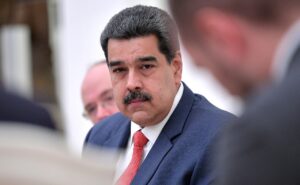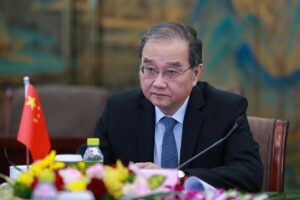South Korea sits in the crosshairs of increasing U.S.-China competition. While the U.S. is its main and trusted security partner, helping deter potential attacks from a nuclear-armed North Korea, China is critical to its economic prosperity. China has been South Korea’s largest trading partner since 2014, and South Korea was China’s third-largest trading partner in 2020. In 2015, China and South Korea signed the bilateral China–South Korea Free Trade Agreement, which boosted annual bilateral trade to over $300 billion in 2018. In November 2020, China and South Korea, along with 13 other Asia-Pacific nations, signed the Regional Comprehensive Economic Partnership (RCEP), the largest free trade agreement in history, covering 30 percent of the world’s population and economic output. China, South Korea, and Japan are also engaged in long-running negotiations for a trilateral free trade agreement to integrate their economies further.
Given these security and economic realities, South Korea is essentially trapped by surging strategic competition between the United States and China. The rising pressure to effectively choose sides between these two big powers is driving South Korea to instead work toward increasing its overall autonomy and cultivating greater cooperation with other middle powers as a way to mitigate these pressures over time.
ROK-China Relations
Historically, Korea-China relations have been more complicated than observed in the modern and contemporary eras. Throughout its history, Korea has been invaded by outside forces 931 times, 438 times from the “Northern continent” [China].1Pong-young Rhu (劉鳳榮), “Foreign Invasions and the Ten Places of Security listed in Chung-Kam-Rok,” 『Baek-san-hak-bo (白山學報)』, no. 8 (1970): 223. Surviving these myriad clashes with China was no small feat and has informed three key lessons for dealing with China. First and foremost, avoid waging war with the Chinese, if at all possible, given their massive size and cultural influence. The second, however, is to react resolutely against excessive Chinese pressure to demonstrate that restraint is not an endless virtue. The third is not to succumb or compromise in the face of Chinese pressure without understanding the long-term consequences, especially for economic and political relations, as the situation, once it unfolds, will be hard to reverse.
Since after the Korean War, the U.S. has been a staunch ally of the Republic of Korea (ROK or South Korea). The U.S.-ROK alliance has been the pillar of South Korea’s foreign and security policies for nearly 70 years through conservative and progressive governments. With U.S. assistance and support, South Korea achieved great success in industrialization and democratization to become the tenth-largest economic power in the world and a vibrant democracy.
At the same time, South Korea’s economic success has been built on trade. In 2020, for instance, South Korea’s economic dependence (the volume of imports and exports over gross national income) was 85 percent, with China making up about one-third of that trade. Its export dependence on China is just second only to Germany among the G-20 major economies worldwide, making South Korea extraordinarily vulnerable and sensitive to outside instability and global trade fluctuations.
That said, the nature of its interdependence with the Chinese economy has also evolved. China has gradually become a competitor in South Korea’s global export markets rather than the destination of its exports, and its non-market practices have driven big Korean businesses out of Chinese markets over time. Moreover, China’s willingness to use economic coercion to influence its political relations is also causing South Korea to begin moving business away from China.
South Korea, in particular, has felt the weight of Chinese coercive power in recent years. In 2016, China opposed South Korea’s deployment of the Terminal High Altitude Area Defense (THAAD) system meant to increase U.S.-ROK missile defense capabilities against North Korea’s growing missile capabilities. The sanctions Beijing imposed in what it considered actions targeted at China, rather than North Korea, resulted in an estimated loss of 7.1 trillion KRW (approximately 5.9 USD) in trade by the end of 2017—losses that went unaided and unmitigated by South Korea’s allies and friends. The effects of this dispute are not easily forgotten in South Korea, making very real the dilemma it faces in ensuring its own security while managing its relationships with the U.S. and China.
U.S.-China Strategic Competition
South Korea’s relations with China are heavily influenced by its alliance relations with the United States. The intensified rivalry between the U.S. and China under the Trump administration, and carried through into the Biden administration, has placed increased pressure on states in the region to choose sides. Framed largely as a struggle between democratic versus authoritarian regimes, narrowly defined nationalism and ideology are driving relations. As such, U.S.-China strategic competition now dominates expanding regional economic cooperation such as RCEP and the Comprehensive and Progressive Agreement for the Trans-Pacific Partnership (CPTPP), as well as security and strategic alliances like the trilateral partnership between Australia, the United Kingdom, and the U.S. (AUKUS) and the Quadrilateral Security Dialogue (QUAD). Therefore, many experts have increasingly depicted U.S.-China relations as entering a new Cold War.
Chinese elites and scholars have harshly opposed such rhetoric. China’s official line remains that bilateral relations should be guided by the principle of “no conflict, no confrontation, mutual respect and win-win cooperation.” Chinese President Xi Jinping described it in his first telephone conversation with U.S. President Joe Biden in February 2021. Wang Yi, Chinese State councilor and foreign minister, made it clear in July 2021 that China takes no interest in betting on winning or losing to the U.S. and hopes to coexist peacefully. In his inaugural address to the annual gathering of world leaders at the United Nations in September 2021, U.S. President Joe Biden also vowed not to pursue “a new Cold War or a world divided into rigid blocs.”
However, in reality, both the U.S. and China seem to treat each other as if in a psychological state of protracted war, with the European Union, the Association of Southeast Asian Nations (ASEAN), and other middle powers serving as their battleground. At the same time, it appears that both the U.S. and China recognize that they can’t actually afford to wage a major world war, neither wanting to shoulder the social or economic impact of armed conflict. However, which country will lead the world in the 21st century depends on more than simply military force, but also their capacity for domestic governance, international persuasive power (soft power), and the public goods they provide to global society.
The U.S. “free and open Indo-Pacific strategy” developed under the Trump administration in partnership with Japan, India, and Australia, was designed to be inclusive and avoid any overt notion of military confrontation while seeking to constrain China with other allies and partners. The Biden administration’s overall China policy has embraced the Indo-Pacific strategy, as well as more overt military projection in the region through the formation of the AUKUS military pact. And while Biden has rejected the notion of a new Cold War, in theory, he has adopted policies that emphasize tough but managed competition with China and forcefully implied the duty of politically like-minded states to get on board.
South Korea as a Lynchpin to Both the U.S. and China
With increased U.S.-China strategic competition, South Korea’s dilemma is that the more it relies on the United States for security, the more its relationship with China runs into trouble, which carries serious economic consequences. ROK President Moon Jae-in has employed a policy of strategic ambiguity throughout most of his presidency, trying to maintain a close alliance with the United States while still developing a substantial “strategic cooperative partnership” with China. But how long it can carry on this two-pronged strategy in the current political environment is unclear. Moreover, whether the next ROK president—soon to be elected—will continue this balancing act remains to be seen.
President Biden has often referred to Japan as a cornerstone for the security and prosperity of the Indo-Pacific region and South Korea as a lynchpin for peace and stability of Northeast Asia. While China is bound to see greater utility in North Korea as a traditional ally and buffer zone amid growing Cold War-like conditions, Beijing tends to pursue a more balanced approach toward Seoul and Pyongyang, aiming to extend its influence over the whole of the Korean Peninsula.[2] Beyond security issues, China also recognizes the enormous value of South Korea to Chinese economic supply chains. Securing a stable and sufficient supply of memory chips from Samsung and SK Hynix, for instance, has become all the more urgent since the U.S.-China rivalry has disrupted its cooperation in strategic technologies and products from the U.S.
But increased U.S.-China rivalry also means attention has diminished on North Korea’s continued nuclear weapons development. While both inter-Korean and U.S.-DPRK talks ended in 2019, Seoul still worries that Washington could strike a deal with Pyongyang at some point in the future that would inevitably come at the expense of South Korean security interests. Establishing peace with North Korea without denuclearization, for instance, would leave the South vulnerable to the North’s nuclear capabilities and coercion.
Furthermore, North Korea’s rapid advancements in its nuclear weapons program factor heavily into South Korea’s efforts to balance its relations with Washington and Beijing. The alliance with the U.S., for instance, provides South Korea with the U.S. nuclear umbrella to help deter North Korea’s nuclear use, although questions are often raised about whether this arrangement is enough given the U.S.’s sole control over how and when nuclear weapons may actually be used. However, the prospects of increasing U.S. deployments in the region to be better prepared against an evolving North Korean threat have often been viewed with great suspicion from China, believing that it is the target of such actions.
Most recently, Chinese coercive measures imposed against South Korea in response to its decision to deploy the THAAD system left a lasting impression on the South. Further deployments of such U.S. assets as medium-range ballistic missiles or long-range guns in the region that could put China’s major cities and military facilities in its eastern coastal areas within range are likely to be viewed with similar suspicion and response. In this case, the security issue would overshadow the whole relationship between South Korea and China, straining economic relations between the two.
South Korea’s Orientation in Foreign and Security Policies
The international security environment drives South Korea to seek new answers. South Korea faces an existential threat from increasing competition between the continental and maritime powers. In this equation—with the U.S. as its major security ally and China as its largest trading partner—hastily taking sides is not really a viable option. The more emphasis is placed on rivalry versus coexistence, the more the region breaks into arms races and competitive small groupings.
In an ideal situation, South Korea would rather see the rise of a new international order where:
- Disputes are resolved peacefully under international law;
- Open and fair markets prevail;
- Economic integration and multilateralism are welcome and should be inclusive and open to all countries;
- Freedom of navigation and overflight are upheld; and
- Progress continues to be sought on denuclearizing the Korean Peninsula.
However, the current trends in the region make this vision unlikely any time in the near future, making it necessary for South Korea to prepare for all scenarios. This means increasing its autonomy over time and building greater cooperation with other middle powers, such as Australia, Vietnam, Germany, Indonesia, and even Japan, to enhance a rules-based international order and reduce the pressures of U.S.-China strategic rivalry. It also means strengthening efforts in crisis management and strategic communications to help avoid conflict and potential military escalation. Overall, while South Korea continues to strengthen its strategic alliance with the U.S. in a more comprehensive way, that development should not turn out to be antagonistic against China.
Notes
- 1Pong-young Rhu (劉鳳榮), “Foreign Invasions and the Ten Places of Security listed in Chung-Kam-Rok,” 『Baek-san-hak-bo (白山學報)』, no. 8 (1970): 223.




